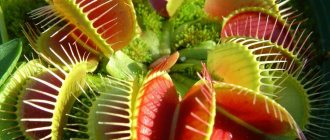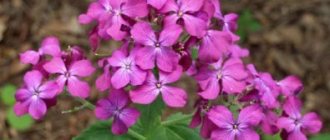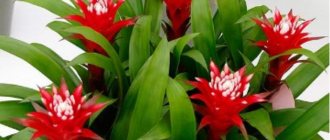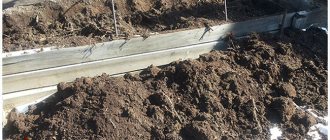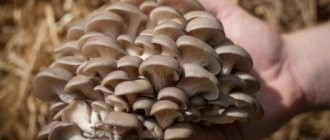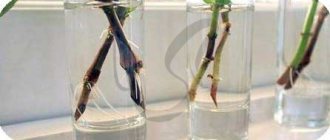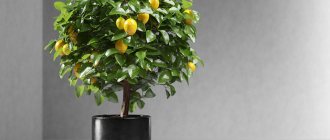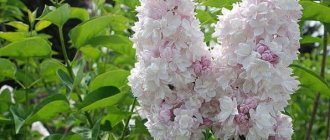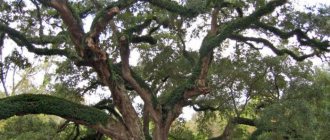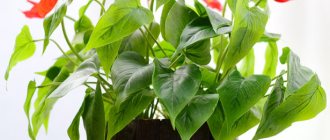What is a Venus flytrap
Discovered in 1760, the flower was named after the Greek goddess of love, Dione. Dionaea muscipula is a small herbaceous plant, a monotypic genus of the Sundew family. The name of the species “muscipula” is translated as “mousetrap” - probably the botanist who described the new specimen made a mistake. The English name Dionaea muscipula corresponds to the Russian one - Venus flytrap - Venus flytrap.
What Dionea looks like - photo
Description
An adult herbaceous insectivorous plant of the sundew family has a rosette of 4-7 leaves 4-7 centimeters long. The stem of the flycatcher is bulbous, does not exceed 15 cm in length. Dionaea blooms with white flowers, which are collected in corymbose inflorescences on a long peduncle and resemble a star in appearance. In nature, the predatory flower grows on soils with a low nitrogen content, so the source of this element is mollusks and insects.
The flytrap's trap leaves are formed after flowering; they consist of two collapsing petals 8-15 cm long and have sparse bristles along the edges. The outer part of the leaves is painted bright green, the internal cavities have a reddish tint. Traps are formed at the end of leaves collected in rosettes - by summer they become longer and take on a vertical position. Inside the trap doors there are glands that produce nectar to attract prey.
In addition to the bristles, there are three triggers on the edges of the slamming petals - when an insect hits them, the trap begins to close and the glands begin to produce digestive secretions. The predatory flower digests food for 5-12 days, after which the petals open again. The duration of digestion depends on the air temperature, the type of digestion process, the size of the prey and the age of the trap itself. The trap dies after it has digested two or three victims, but there have been cases when one leaf became the grave of seven insects.
Plant information
In America, this species is included in the list of endangered plants. Floristic predator is the only perennial insectivorous herbaceous plant of this species of the Rosyankov family. The plant is not tall; in adulthood it does not grow higher than 15 cm. The stem of the Venus flytrap is bulbous. Small white flowers are collected on tall peduncles in a corymbose peduncle.
Since the soil where this amazing plant grows has a very low nitrogen content, the source of this chemical element is various insects and even slugs.
The leaves, forming a rosette, grow from a short underground stem from 3 to 7 pieces (depending on age). These insect traps grow back after flowering. Their length is from 6 to 15 cm. The “mouth” is green, but with good consecration its inner part turns red. Inside there are glands that are capable of producing odorous nectar to attract insects. Along the edges of the trap there are hairs and triggers; when a victim gets inside, they are irritated and the trap slams shut, and the plant begins to produce digestive secretions.
Digestion lasts several days, then the predator opens the insidious bait leaf again. After several successful hunts (5-7 times) for insects, the leaf can no longer produce digestive secretions in sufficient quantities. It dies off, giving way to a new predator leaf. As stated above, the Venus flytrap prefers open sunny and wet meadows of North Carolina or swamps with peat and sandy soil in South Carolina. Despite the fact that the plant prefers to live in a swamp, it does not tolerate stagnant water.
What does it eat?
A specimen of the flycatcher, found in the swamps of North or South Carolina, feeds on insects. Dionaea peatum, growing in its natural environment, is close to the ground, so flying or crawling “food” itself falls into traps. A plant bred at home will need to be fed by you yourself. Live flies or any arthropods half the size of the trap are suitable for this.
Popular message topics
- Rights of the child
Absolutely every person born on Earth has rights and responsibilities. Of course, all children are endowed with certain rights from birth. Child rights include those rights and freedoms that any child is entitled to. - Non-positional number systems
An algorithm in which a digit does not occupy a significant position in a number is called a non-positional number system. At the same time, the number system can be arranged in descending order. There are several forms of systems: - City of Kazan
Eight hundred kilometers from Moscow, on the banks of the great Volga River, there is a large and ancient city, which is called the third capital of Russia. This is Kazan, the main city of the Republic of Tatarstan, a link between two cultures, east and west.
How does the trap closing mechanism work?
The main distinguishing feature of the flower is its trap leaves. Inside each such trap there are small hairs that act as sensors. A single exposure to a hair will not cause the petals to close. This helps Dionea avoid “idle” slamming, which can occur due to branches or raindrops hitting the trap surface.
The petals close instantly when an insect touches two or three different hairs. No one can say what the exact mechanism of the trap is, but scientists read that the closure occurs due to the instantaneous transfer of water between the cells of the flower. After the Venus flytrap's petals close, it releases digestive enzymes and dissolves the insect. After two weeks, the trap is again ready to search for prey. During its life cycle, each trap can digest up to 7 victims.
- Doctors question the use of mechanical ventilation for COVID-19
- 8 best garden vacuum cleaners
- How to choose a car for a beginner
Compression phase
If the initial slam of the trap is successful, the compression phase begins, which lasts about half an hour. The process looks like this. During the struggle, the insect inside the trap continues to touch the “trigger hairs.” This signals the flycatcher that it needs to further clamp the flaps to keep the victim inside. If the insect is small enough, it can slip through the teeth of the trap and escape.
The compression phase does not occur if the slamming is unsuccessful in finding prey. This happens if, when the flaps collapse, the insect manages to get out of the trap or vibrations of the hairs occur, caused by other leaves, raindrops, or a person who stuck his finger there. Then the trap begins to slowly open and opens completely in a day or two. But if such touching of the hairs occurs several times, it can lead to blackening and death of the trap. In subsequent times, the rate of collapse of the same trap drops significantly.
Venus flytrap - home care
The predator plant is very popular among gardeners, because it can be grown at home or in the garden. Many people are interested in how to care for the flycatcher at home, because the carnivorous flower is capricious. For normal growth and development, Dionea needs to be provided with conditions similar to natural ones: maintaining high air humidity, the required temperature, watering it in a timely manner and periodically feeding it with caught insects.
How to choose the best place to grow
The best place for a Venus flytrap is the window sills oriented to the west or east - this way the flower will be in good light for the required amount of time - about 4-5 hours/day. In hot summer weather, you should avoid exposing the plant to the scorching rays of the sun. If there is not enough light, give the flower artificial lighting using fluorescent lamps with a power of 40 W or more. Remember that you cannot rotate the pot with Dionea or change the location of the lamp, as she reacts negatively to this.
Optimal air temperature and humidity
During active life, the air temperature in the room where the sundew grows should be maintained constantly within 22-27 degrees. Venus can tolerate higher temperatures, but it should not be higher than 35 degrees. Keep an eye on the humidity level: the range can be 40-70%. In addition, keep in mind that the fly eater cannot grow normally in stagnant air - the room will need to be regularly ventilated, but there should be no drafts.
Watering Dionea
The roots of the fly beetle are not able to process earthen mineral salts, so neither filtered nor tap water should be used for irrigation. Only distilled, rainwater or purified by reverse osmosis is suitable. The substrate must be constantly moist, since traps may die due to lack of water. To maintain optimal soil moisture, it is better to keep the pot with the flower on a tray filled with enough liquid so that the drainage holes at the bottom of the dish are immersed in it - the roots of Dionea will replenish their need for water themselves.
Top dressing
When growing a plant that catches flies at home, it is important to provide it with conditions close to its natural habitat: to do this, you first need to monitor the acidity of the soil in the pot. The required concentration can be achieved by mixing equal parts of perlite and sphagnum moss. Dionaea does not require fertilizing with organo-mineral fertilizers, like other indoor flowers.
Kinds
Currently, about 25 domestically cultivated species are known. Some types are especially popular.
Venus flytrap Mouth (Dionaea Jaws.)
The traditional shape of a flycatcher, only the teeth are triangular in shape. Feeding and care are the same.
Dionea Mouth
Venus flytrap (Dionaea Bristletooth)
Distinguished by bright red traps. The teeth are short and sparse. This species produces a fairly large number of children.
Dionea bristly
Venus flytrap Fondue (Dionaea Fondue)
This species is highly mutated. There are species with traps of different colors, sometimes completely devoid of teeth.
Dionea Fondue
Venus flytrap Low Giant (Dionaea Low Giant)
Has the biggest traps. Looks very interesting at home. Feeding looks the most obvious.
Dionaea the Low Giant
Venus flytrap Dionaea Long Red Fingers
A very mutated species, has bowl-shaped traps. The teeth are bright red, often fused. They grow close to each other.
Dionea Long Red Fingers
Venus flytrap Red Dragon (Dionaea Red Dragon)
It has original leaves and burgundy-colored traps. With a lack of lighting, the color of the traps fades.
Dionea Red Dragon
Plant cost
The price of the plant varies depending on the age and rarity of the species in our country. The lowest price is 100 rubles (discounted and small plants, the best option for the first growing experience) and rises to 700 rubles (selected, best specimens). Seeds can be ordered in St. Petersburg for 100 rubles per package. Check expiration dates carefully.
Wintering and rest period
In autumn, new leaves stop growing on the plant - it is preparing for hibernation. To help Dionea enter winter dormancy, it is recommended to reduce watering to a minimum and no longer leave water in the pan. When the flycatcher hibernates, the pot with it needs to be moved to a dark place where the temperature does not exceed 7-10 degrees. You can take the flower out onto a glassed-in balcony or even put it in the refrigerator.
Until spring, the predator plant does not require either nutrition or special lighting. The only thing you will need to do is water the soil occasionally, but you shouldn’t overdo it here either, because an excessive amount of moisture will lead to rotting of the roots. A flycatcher that has fallen into hibernation does not look attractive - its leaves become brown and die off.
- Treatment of nail fungus during pregnancy
- 8 ways to save on taxis
- 7 ways to track Android via Google
Care
Feeding
The most difficult, and at the same time fascinating process is feeding the plant. You cannot use fertilizers to avoid this procedure, Dionaea is a predator, and it receives all its nutrients from insects. Suitable food sources include spiders, flies, small cockroaches and mosquitoes. If a large insect (such as a cockchafer) gets into the trap, the trap will not be able to digest it. And then it turns black and dies; it must be carefully trimmed.
Digestion of food takes the flycatcher from 10 days to two weeks. Only when the trap opens completely does it mean it is ready to eat. The question always arises: where to get live insects for feeding?
- In summer, you can take the plant out onto the terrace; the smell of nectar will attract food. You just need to make sure that large insects do not fall into the traps;
- Some people raise flies from maggots, which are found outdoors in rotting meat or fish. But this procedure is not suitable for everyone, just like growing mosquitoes from bloodworms;
- Sometimes in a garden plot they lay out adhesive tape not far from the anthill, and catch the ants with tweezers in a jar;
- You should not feed the flycatcher if the plant is weakened by disease or after transplantation.
You should not feed the flycatcher pieces of meat, and under no circumstances feed gnawing caterpillars. During the winter, the Venus flytrap goes without live food until spring, when insects begin to emerge.
The traps are fed with tweezers by dropping a fly or ant into the trap. During the entire growing season of Dionea, 3 flies or large mosquitoes are enough .
Watering
The Venus flytrap is not watered, it is given water in a tray, and through the holes in the pot it flows into the roots. Most importantly, the water should be rainwater (of course, not from a dirty city roof) or distilled. It is very important for the plant that the water is as soft as possible. During the active growth stage, water at least three times a week.
You cannot use ordinary water, melted, filtered, settled, this will lead to the death of Dionea!
Check the soil for moisture every day. Drying out the earthen coma is detrimental to the exotic plant. Choose a pot for the plant that is tall and has a small diameter, since the roots of the Venus flytrap are long. In nature, the plant lives in flooded meadows or peat bogs, where there is a lot of underground water. Therefore, it does not need watering from above. Water can get into the traps and damage them.
Lighting
The most favorable location for a predatory flycatcher in an apartment is south-eastern and south-western windows. The plant should receive at least 6 hours of light in the morning and the same amount in the evening. If the plant is planted in a florarium, which provides high humidity, artificial lighting may be needed. A 40-watt lamp is placed at a height of about 25 cm, depending on the size of the plant, and left on for 15 hours.
In summer, Dionea can be taken out to a balcony or open loggia, but care must be taken to ensure that the flower is not exposed to direct sunlight. For proper development, the plant needs light, but everything needs moderation. There is no need to rotate the pot as you do with other plants - the Venus flytrap does not like to be disturbed.
Temperature
In summer, the optimal temperature for the plant is from 20 to 30 degrees Celsius. Therefore, you can easily take it to the warm side of the veranda or terrace. In winter, during the rest period, the temperature is reduced, but not below +8 degrees.
Humidity
The Venus flytrap loves humid air of 50-70%, but this is difficult to achieve without spraying. It’s good if it is planted in a florarium, natural humidity is maintained there. She also doesn’t like stagnant air, but drafts are also contraindicated for her. Ventilate the room as needed, but not for long. If it grows in a pot, then you can put a bowl of water. The evaporation will moisten the dry air of apartments directly near the flower.
The soil
The most suitable substrate should correspond to natural conditions and consist of:
- 4 parts sour peat (better to buy at a flower shop);
- 2 parts perlite, soaked in water for a week;
- 1 part coarse river sand (boiled in distilled water).
In this case, drainage is not needed, since the roots are fed with water from the pan. The tray must be high enough. It is important that the plant is planted only in plastic or glass pots. Ceramic and clay are prohibited due to the high acidity of the substrate.
Transfer
An adult plant is replanted only in a healthy state in the spring. This procedure is carried out once a year, after wintering. When replanting, care must be taken, since the roots are very fragile, any damage to the roots leads to difficulties for the plant to take root in a new place.
Using the transshipment method, remove the root system and clean it of old soil. If it is difficult to separate, soak the roots in water and then rinse with a spray bottle. After transplanting into a new pot, the plant will need about a month to adapt, so the transplanted flower should be protected from bright sunlight and watered more often.
Fertilizer
No fertilizer is added to the soil for the Venus flytrap in any form, since it receives all the necessary nutrients from insects.
What to feed a Venus flytrap at home
It is imperative to know all the intricacies of flytrap nutrition if you decide to buy Venus for breeding at home. The plant can be fed with insects: flies, spiders and bees, but only live ones, because the production of a digestive enzyme occurs only when the prey moves. In summer, an adult flower growing in a room needs to eat 2-3 victims. Those flowers that grow on the street do not need to be fed at all - they are able to catch insects on their own. Remember that too hard food or meat will cause the trap to rot.
Features of plant nutrition and feeding
The Venus flytrap does not need to be fed with various fertilizers, receiving all the necessary nutrients from the insects it digests. If there are no insects in the room or container where the plant is kept, it is necessary to feed one live fly, mosquito, spider and other small insects once every one to three weeks.
Read about how the Venus flytrap behaves in the wild and about the peculiarities of its feeding in our article “Venus arranging flytraps (+ video).”
Typically, digestion of prey takes 5-10 days. It is not recommended to feed the plant with beetles, caterpillars, larvae, bloodworms, earthworms, meat, etc. They are difficult for traps to digest and can cause them to rot. The feeding itself should be stopped at the end of September, gradually lowering the air temperature and the flycatcher should be transferred to “wintering”.
How does a plant reproduce?
The flycatcher reproduces in different ways - by cuttings, seeds or dividing the bulb. Obtaining Dionaea seeds is the longest and most complex process. As the flower grows, bulbs appear; they are cut off and replanted. Cuttings can also be cut and planted in the soil, after which you need to cover the pot with flower stalks with film. The flyeater reproduces when a certain temperature is maintained (no more than 25 degrees) and optimal humidity is provided.
Growing Dionea from seeds
To get sundew seeds, you need to pollinate its flowers yourself using a cotton swab or brush. If the process was carried out correctly, then within a month small boxes with seeds will appear. They need to be sown three months after pollination, otherwise germination is then lost. If the seeds have been stored longer, then before planting you need to stratify them - keep them in the refrigerator for a month and a half, after wrapping them in sphagnum and sealing them in a zipper bag.
When planting, scatter the seeds over the surface of the soil and spray with soft water using a spray bottle. Do not forget to comply with the requirements for placing crops - place the containers in the greenhouse under bright, diffused sunlight or artificial light. Maintain the room temperature at about 24-29 degrees, make sure the soil is always moist. You will see shoots in 2-3 weeks. After another 2-3 weeks, when the Venus flytrap seedlings grow up, you can place the flower in a pot whose diameter does not exceed 8-9 cm.
Propagation by cuttings
From Dionea you need to carefully cut off one leaf and process the cut using Kornevin. Having placed the cutting at an angle, plant it in a substrate of peat and quartz sand. After this, you can cover the container with a transparent cap and leave it at room temperature under bright light until the cuttings begin to sprout – this often happens after three months. Remember that rooting is not recommended, otherwise the cuttings may be affected by fungi.
Dividing the bush
Propagating flycatchers using this method is much easier. It is best to do this during transplantation of Dionea: a flower 1-2 years old is removed from the pot, then the roots are freed from the soil and the daughter rosettes are separated from the adult plant using a sterile instrument. After this, the rosettes are planted in separate pots, put away in partial shade until they take root in the new substrate.
Bloom
Dionaea begins to bloom in May - June. Flowering continues for several weeks. The plant produces tall peduncles on which corymbose inflorescences are formed. The flowers are small, up to one cm in diameter, very attractive and have a pleasant aroma.
If you do not plan to carry out pollination and collect seeds in the fall, then it is better to cut off the arrows during the budding period. Flowering and seed ripening greatly weakens the plant, especially the traps. If you want to get seeds, use a plant that is older than a year and wait until the capsules are completely ripe.
Diseases and pests
Who would have thought that a plant that can eat insects could also suffer from them? There have been cases when aphids infested the surfaces of traps, causing them to become deformed. Special insecticides are sold against small insects. The predatory flycatcher flower can also be affected by spider mites: treatment with an acaricide solution will help destroy the pest.
Dionaea needs special care: where it grows, it is necessary to maintain optimal air humidity and temperature conditions. However, if the soil is too wet, the flower may suffer from sooty fungus - a black coating will appear on the leaves and stems. Fungicides will help fight it. If the maintenance conditions are not met, the flytrap is attacked by botrytis - a gray fluff of mold. If you notice the appearance of such mold, immediately remove the affected parts and treat the plant itself with a fungicide solution.
Bactericidal damage to Dionaea can also occur due to the fact that the trap cannot cope with digesting the caught insect. In such cases, the closed petals turn black and rot, and the disease quickly spreads throughout the plant. You need to immediately cut off the damaged trap, and then treat the flower with a fungicide solution.
Interesting facts and videos
- In the collection of carnivorous plants that Thomas Jefferson, the third President of America, was very fond of, the Venus flytrap occupied the most honorable place. He fed her only with his own hands;
- Charles Darwin dedicated a whole book to this plant, where he wrote in detail what and how to feed it;
- Another unique feature of the Venus flytrap is that the traps not only emit a pleasant aroma, but also glow slightly with a bluish light, all to lure insects;
- Some types of flycatchers determine the size of the insect and if it is larger than it needs, the trap doors open and the insect regains freedom;
- To date, breeding scientists have developed subspecies of the Venus flytrap with red and crimson wings. They are found only in botanical gardens, and the cost of an exotic plant is very high.
